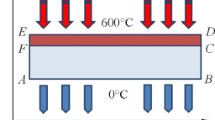The high-priority task of creating efficient thermal protection of various-purpose objects from direct external hightemperature effects is studied. This article proposes a solution to the problem of identifying the thermophysical properties of the materials, which decompose in the course of the chemical interaction and which are used in heatshielding structures. The admissible temperature conditions of a protected object are provided by a multicomponent heat-shielding coating, the components of which, when the temperature threshold is reached, enter into a twostage endothermic reaction with absorption of excessive heat. The thermophysical characteristics of a heatprotective coating to be identified are determined by the solution of the corresponding inverse thermal conductivity problem formulated in a minimax variation form relative to the discrepancy between the results of thermophysical experiment and of mathematical simulation. The parametrization of the identifiable equivalent heat capacity narrows the domain of the search for solutions to a collection of piecewise continuous functions and reduces the set original variational problem to the parametric problem of semi-infinite optimization, whose solution, based on rather general alternative properties of the optimal temperature residual, makes it possible to minimize this residual in a uniform evaluation metric.
Similar content being viewed by others
References
A. S. Okhapkin, Study of the heat-transfer characteristics of a thermally protective composite material, J. Eng. Phys. Thermophys., 49, No. 6, 1469–1473 (1985).
O. M. Alifanov and V. V. Cherepanov, Identification of models and prediction of physical properties of highly porous heat-shielding materials, J. Eng. Phys. Thermophys., 83, No. 4, 770–782 (2010).
D. Ya. Barinov and P. V. Prosuntsov, Simulation of heat transfer in a layer of decomposing material of a heat-protective coating of a lander, Vestn. Moskovsk. Gos. Tekh. Univ. im. N. É. Baumana, Ser. Mashinostr., No. 6 (111), 22–32 (2016).
A. S. Yakimov, Mathematical Simulation of Thermal Protection and of Some Problems of Heat and Mass Transfer [in Russian], Izd. Tomsk. Univ., Tomsk (2015).
O. M. Alifanov, S. A. Budnik, A. V. Nenarokomov, and A. V. Netelev, Identification of mathematical models of heat transfer in decomposing materials, Tepl. Prots. Tekh., 3, No. 8, 338–347 (2011).
O. M. Alifanov, S. A. Budnik, A. V. Nenarokomov, A. V. Netelev, and D. M. Titov, Destructive materials thermal properties determination with application for spacecraft structures testing, The 61th Int. Astronautical Congress, 27 September–1 October 2010, Prague, Czech Republic. IAF Publ. IAC-10-C2.7.5, 2010, 10 p.
J. A. Dec, R. D. Braun, and B. Lamb, Ablative thermal response analysis using the finite element method, J. Thermophys. Heat Transf., 26, No. 2, 201−212 (2012).
N. V. Pavlyukevich, G. E. Gorelik, V. V. Levdanskii, et al., Physical Kinetics and Transfer Processes in Phase Transformations [in Russian], Nauka i Tekhnika, Minsk (1980).
Yu. V. Polezhaev, S. V. Reznik, É. B. Vasilevskii, et al., Materials and Coatings under Extreme Conditions. Outlook on the Future, Issue 3, Vol. 1, Forecast and Analysis of Extreme Effects [in Russian], Izd. Moskovsk. Gos. Tekh. Univ. im. N. É. Baumana, Moscow (2002).
S. V. Reznik, P. V. Prosuntsov, and K. V. Mikhailovskii, Prediction of the thermophysical and thermomechanical characteristics of porous carbon–ceramic composite materials of the heat shield of aerospace craft, J. Eng. Phys. Thermophys., 88, No. 3, 594–601 (2015).
Yu. V. Polezhaev, Heat Transfer and Heat Shielding [in Russian], Yanus-K, Moscow (2008).
V. L. Strakhov, A. N. Garashchenko, G. V. Kuznetsov, and V. P. Rudzinskii, Heat and mass transfer under heat and fire shielding with account for the processes of thermal decomposition, evaporation–condensation, mass entrainment, and bulging–shrinkage, Mat. Modelir., 15, No. 5, 107–113 (2000).
V. L. Strakhov, A. N. Garashchenko, G. V. Kuznetsov, et al., Possibilities of the method of mathematical simulation of the heating-through constructions with thin fire-shielding coating under fire conditions, Vopr. Obor. Tekh., Ser. 15, Issue 6 (100), 15–18 (1991).
O. M. Alifanov, Inverse Heat Exchange Problems [in Russian], Mashinostroenie, Moscow (1988).
J. V. Beck, B. Blackwell, and Ch. R. St. Clair Jr., Incorrect Heat Conduction: Ill-Posed Problems [Russian translation], Mir, Moscow (1989).
A. A. Samarskii, The Theory of Difference Schemes [in Russian], Nauka, Moscow (1983).
M. Yu. Livshits and N. A. Kadyrova, Characteristic features of state observers for identifying the physicochemical properties of oil fractions at the atmospheric–vacuum pipe still installation, Vestn. Samarsk. Gos. Tekh. Univ., Ser. Tekh. Nauki, No. 4 (32), 186–198 (2011).
M. Yu. Livshits and D. B. Kadyrov, Optimization of the process of dewaxing on the basis of identification, Tepl. Prots. Tekh., 3, No. 2, 71–78 (2011).
K. B. Isaev, Thermophysical Characteristics of Materials in Wide Temperature and Heating Rate Ranges [in Russian], Kupriyanova, Kiev (2008).
É. Ya. Rapoport, Alternance Method in Applied Optimization Problems [in Russian], Nauka, Moscow (2000).
A. N. Diligenskaya and É. Ya. Rapoport, Method of minimax optimization in the coefficient inverse heat-conduction problem, J. Eng. Phys. Thermophys., 89, No. 4, 1008–1013 (2016).
O. F. Shlenskii, A. G. Shashkov, and L. N. Aksenov, Thermophysics of Decomposing Materials [in Russian], Énergoatomizdat, Moscow (1985).
Yu. É. Pleshivtseva and É. Ya. Rapoport, Method of successive parametrization of controlling effects in the boundary-value problems of optimal management by systems with distributed parameters, Izv. Ross. Akad. Nauk, Teor. Sist. Upravl., No. 3, 22–33 (2009).
É. Ya. Rapoport, Yu. É. Pleshivtseva, and A. N. Diligenskaya, Constructive method for optimizing controlled systems with distributed parameters, in: Proc. 18th Int. Conf. "Problems of Controlling and Simulating in Complex Systems," SamGTU, Samara (2016), pp. 317–324.
K. É. Plokhotnikov, Computational Methods. Theory and Practice in MATLAB Medium [in Russian], Goryachaya Liniya-Telekom, Moscow (2013).
Author information
Authors and Affiliations
Corresponding author
Additional information
Translated from Inzhenerno-Fizicheskii Zhurnal, Vol. 94, No. 6, pp. 1625–1634, November–December, 2021.
Rights and permissions
About this article
Cite this article
Al’debenev, N.S., Ganigin, S.Y., Demoretskii, D.A. et al. Identification of Thermophysical Characteristics of Chemically Interacting Materials of Heat-Protective Coatings. J Eng Phys Thermophy 94, 1590–1599 (2021). https://doi.org/10.1007/s10891-021-02440-4
Received:
Published:
Issue Date:
DOI: https://doi.org/10.1007/s10891-021-02440-4



